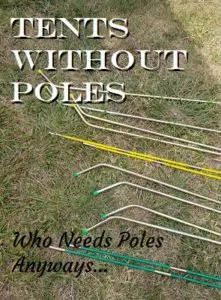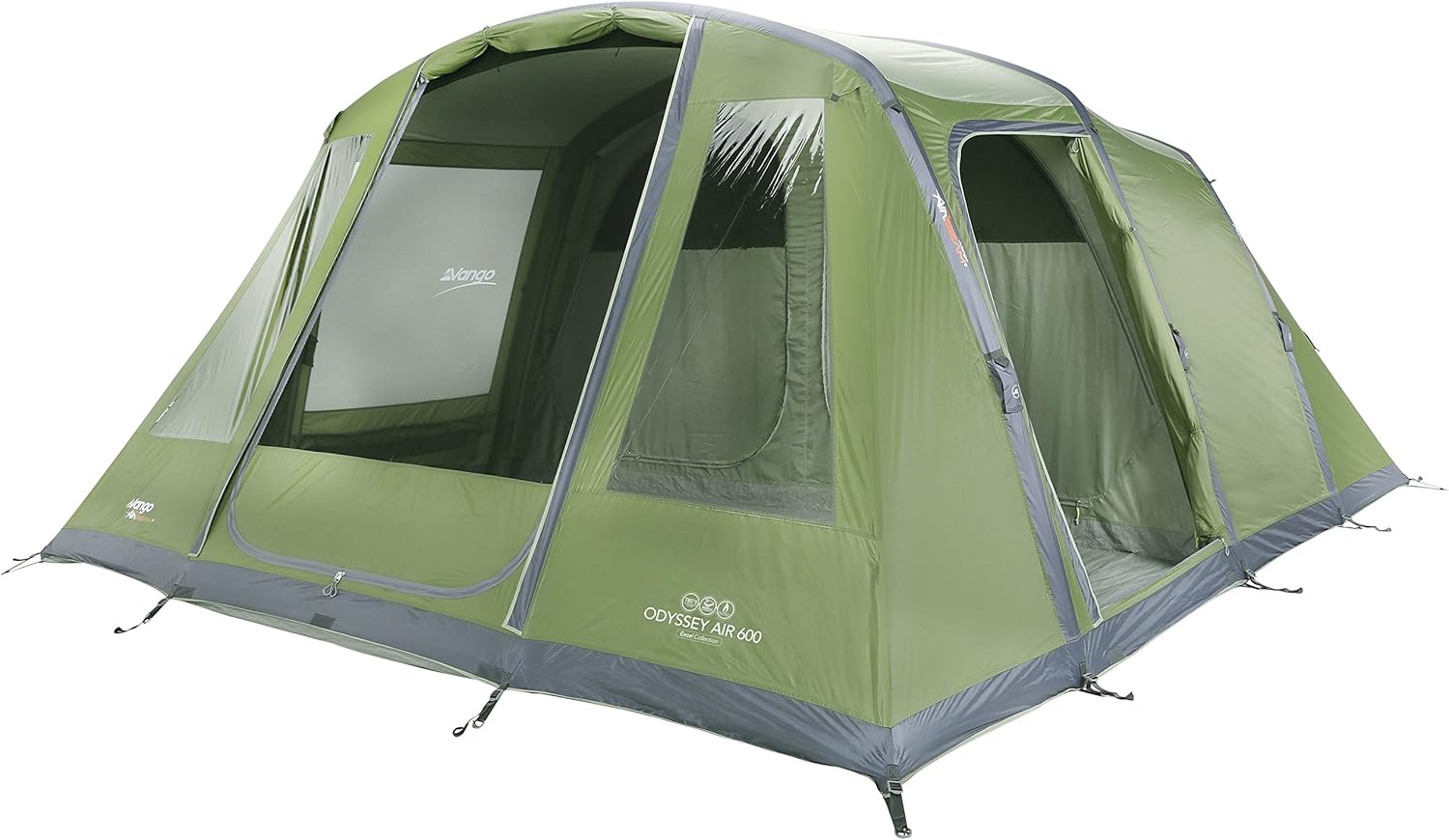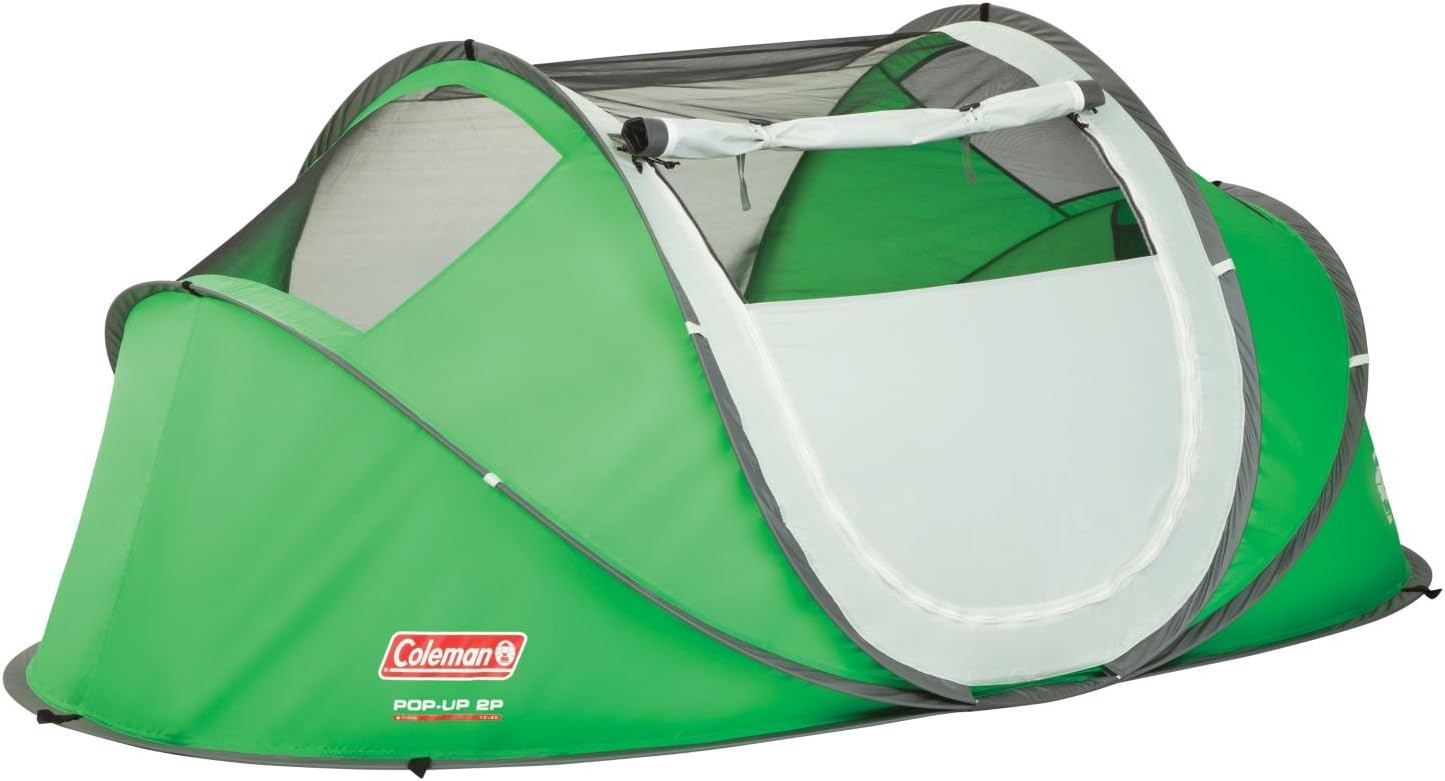
The saying, ‘tents without poles’ can mean one of two things. 1. You’re looking for tents that don’t require poles during assembly or 2. how to pitch a tent without using poles.
Fortunately, I’ve got both covered in this article. First, you can find a few tents that don’t require you to carry around heavy and awkward poles on your next camping trip.
This not only makes traveling with them lightweight, but also frees up a little space in your vehicle. Tent poles can be an awkward item to store, especially back in the tents carry bag. More often than not you need to carry the poles in a separate carry bag as they don’t fit back into the original tent bag.
With these tents, you don’t need to worry about finding room for your poles. In fact, you don’t even need to remember to bring the poles because they don’t exist.
Following these tents without poles in their assembly is a video and short guide on how to assemble a tent should you have forgotten to bring your poles. I’ve done this before and believe me, it’s not fun. But one can work their magic and manage to assemble a pretty basic tent without the use of any poles provided you have either guyline, branches, and some nearby trees.
Inflatable Tents Don’t Have Poles
There is a lot to like about this tent from Moose Outdoors with its inflatable set up being one of the most unique styles of tents without poles on the market. Having no poles gives it a few advantages over your traditional pole based tents which comes in handy when you go camping.
The biggest advantage of the inflatable tent is just how quick and easy it is to set up and take down. It only takes a few minutes to get it set up which is really useful when you don’t have a lot of time to get set up. When it comes to taking it down it’s as simple as releasing a valve to let it deflate than pack it up.
The other advantage is of course how compact it is and lightweight. With a regular tent, the poles can weigh a ton, with an inflatable tent like this, it weighs just 15 lb. As there are no poles, the tent is more compact when folded down for easy transport. No pole poles sticking out of the tent bag or ripping the carry bag.
It May Have No Poles, But Don’t Underestimate It
This tent is made out of a quality ripstop fabric that is very durable like other quality tents. Not only is it durable it allows this tent to breathe really well in the warmer months of the year. I know what you’re thinking, if it has no poles, how does it hold up against strong winds.
While it may not be one of the best tents for high winds, it can still handle winds up to 33mph. This is still pretty decent wind speed and considering this tent has no poles, its quite incredible.
High Level Waterproofing
This tent has a good amount of waterproofing with it being rated as 3000 MM water-resistant. This works really well with the attached groundsheet which helps keep the water out from the ground.
But its the fact this tent can be assembled without using any poles that make it a clear winner. The tent comes with a hand pump similar to the ones you use to pump up inflatable paddleboards. To pump up the tent you just insert the pump into the valves of the tent and start pumping it up where the joints of the frames are.
In under 3 minutes you can have a completely assembled tent ready for use. The tent also comes with a repair kit should you make a hole in the ripstop material.

Vango 6 Person Tent – No Poles
This tent by Vango is an impressive bit of work with it also being an inflatable tent like the Moose Outdoors tent above. This gives it the same advantage as the model above with how quick and easy it is to set up and take down which will always be an advantage.
However, this tent is slightly bigger being a 6 person with two rooms. I actually prefer the Vango tent for this reason. Having a separate room like this does give the tent more possible sleeping arrangments.
One of the advantages of an air beam tent is how rigid they are when fully set up. Unlike your more traditional poles that if they aren’t set up just right the tent can be a little loose and not nice and tight. It’s much easier to achieve this with an air beam tent.
Detachable Groundsheet
Cleaning the inside of your tent can be a difficult task which thankfully Vango has made that much easier. The groundsheet can be detached which makes cleaning the floor of your tent a lot easier since you can just detach it and shake all the dirt or sand off it.
Letting light into a tent is a good and bad thing as you want to let some in but want to keep it out when you sleep. Vango made the clever design choice by giving this tent a light out room that has a divider which makes sleeping in the tent that much better.
The flysheet is made out of a 70D 4000MM polyester which is extremely water-resistant which gives you peace of mind when camping in a rain heavy area. This tents waterproofing is impressive and possibly one of the best waterproof tents on the market in my opinion.
Overall this is a fantastic tent that removes a lot of the hassle out of setting up a tent and dealing with wet weather. These two things alone make this tent worth it but add in the front room and this tent an easy recommendation in my opinion.

No Pole Pop Up Tent
Another type of tent that doesn’t use poles is a pop up tent. While technically this tent does have poles they’re not the type where you need to manually set the poles up since it’s a pop-up tent. They are more of a flexible bending wire than a pole.
This is why I’ve included this impressive Coleman tent since it removes the hassle of dealing with tent poles and makes set up that much easier which is the biggest advantage of no pole tents.
Quickest Set Up & Lightweight
Out of all the tents without poles, the pop-up variety is the quickest to assemble. In a matter of seconds, you can have this tent set up and ready to go. This is achieved by unlatching the latch and then the tent just pops up into shape right before your eyes.
This is a very lightweight tent which makes it excellent for those who like to backpack camp and need reduced weight with it roughly weighing around 5.8lbs. So carrying it isn’t an issue and makes a good tent for the kids if they go on camping trips with friends or the scouts.
One thing that stands out about this tent is that it’s not just water-resistant, but also has some fire resistance as well. While the added bonus of fire resistance is a nice touch it’s the water resistance that is more useful and what you’ll most likely need. But the fire protection is something that’s appreciated.
2 To 6 Person Tent
Being a smaller 2 person tent does mean it’s not going to appeal to everyone, but for a 2 person tent it has a good amount of space in my opinion. It measures an impressive 7ft 6 inches by 4 ft 5 inches and then has a center height of 2ft 11 inches.
If the 2 person tent is too small for you, Coleman also makes this tent available in 4 or 6 person. There aren’t too many larger pop up tents than this either.
Superb Rainfly
The rainfly is one of these tents’ best features in my opinion as it’s considered to be a multi-position rainfly. This gives the tent the ability to offer more ventilation when you need it or add extra protection from the elements. This makes where you set your tent up a far smaller issue as the rainfly can make up the difference at times.
This is a quality tent that works really well for a backpacking tent and setting up is without a doubt one of the easiest things to do. Which is exactly what this tent set out to do and with Coleman backing it makes this one easy tent to recommend.

How To Pitch A Tent Without Poles
I don’t think I’ve ever met a camper who has never forgotten something when they’ve camped with some people forgetting worse things than others. There is nothing like the feeling after arriving at your campsite after several hours driving just to see you forgot your tent poles. Knowing you can’t just buy more poles at the drop of a hat, what are you to do?
Thankfully there are things you can do that will hopefully save you from having to buy a new tent but it will require a few things to get the job done. Whether you can find these things at the campsite will come down to how lucky you are, but the chances are pretty high.
Pitching A Tent With Just Guyline-Rope
What You Will Need To Assemble A Tent Without Poles
The first thing you will need to do is scout around for some long straight branches that have a really high amount of flexibility in them. These are what you’ll be using as replacement poles so they need to be longer than where your poles normally go.
Once you’ve got your branches you need some strapping as these will be needed to anchor towards some trees. Since staking into the ground is basically impossible with this setup. Having some extra cords will be useful so if you do have them make sure you get ready to use them.
Now you’ve got all your equipment it’s time to find an area to set it all up. The best place to set it up is between 2 trees since these will be your anchor points when setting up. You need to make sure you do your normal set up things here like clear debris, and make sure it’s not a place where rain will settle.
The Next Step!
Now you’ve got all the gear and found the spot you’re going to set your tent up. The next thing you’ll want to do is clean the branches and make sure they can’t tear through the fabric of your tent. Once that’s done you need to feed them through where you’d normally put your tent poles.
Your tent should be in its set up position and you’re ready for the next step. This is where you’ll get your strap and tie it around one of the trees as your first anchoring point. From here you will want to feed it through the top of your tent just under the branches and anchor it to the other tree.
If you have some extra rope that I mentioned then this is a good time to use it and help anchor it even move. If you’ve done everything right and the branches you chose are strong enough to hold the tent then you’re ready to go!
If you haven’t already done so, plan ahead for staking your tent in hard ground. Regualr tent stakes may not be up for the task, especially in hard clay areas. These tent peg alternatives may prove a life saver for your next camping trip.



